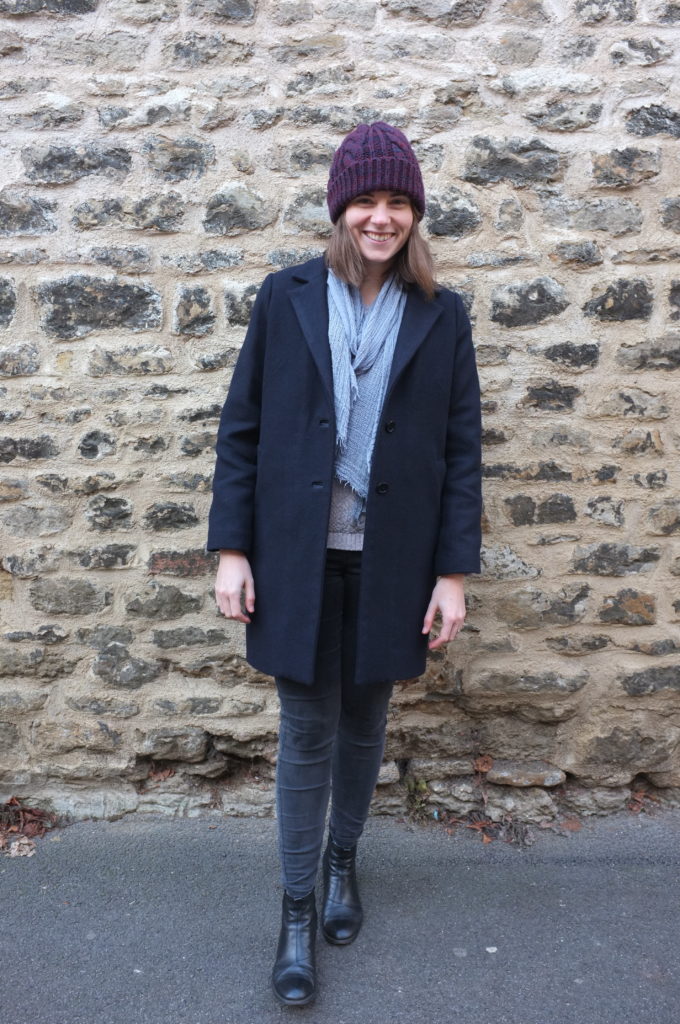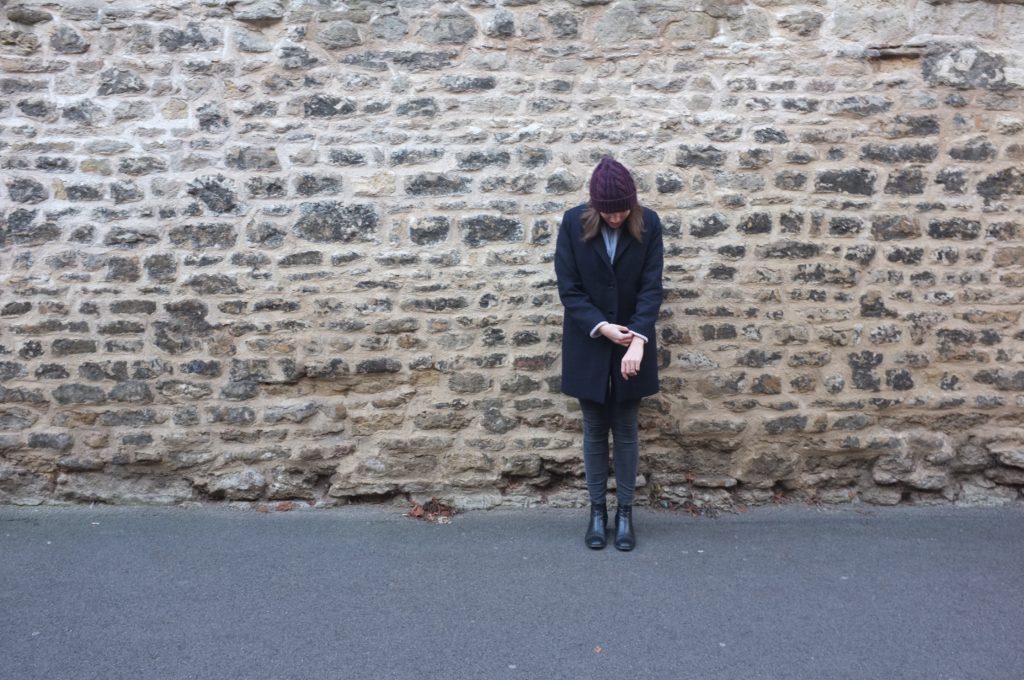 Hello everyone, I made a winter coat!
Hello everyone, I made a winter coat!
(Just a quick warning, this post is super long, so feel free to skip to the end if you are not interested in all the coat making details.)
I’ve been planning this coat for a long time. If you’ve been following me over at Instagram for a while, you will know that I started planning this coat last autumn. I’ve been wanting to make a coat for years now, but could never find the right pattern. I was looking for just a simple, classic design but it was surprisingly difficult to find a coat pattern that I liked (see my sketch below for what I envisioned). I even submitted my design to The Fold Line when they had a pattern competition last autumn. I didn’t win, but just after I had submitted my design, Waffle Patterns came out with the Bamboo Coat which was relatively close to my inspiration sketch. Knowing that it would have thorough instructions, I decided to go for it and just change some of the elements.
The next hurdle I had was finding the right fabric. Of course I would have loved to make the coat in this pink colour from the sketch (because I am still obsessed), but in the end I wanted to make a more versatile coat that could become a staple for any occasion. However, even after having decided to go for a more classic colour, I just couldn’t find a fabric that I was passionate about, and wool coating is quite expensive after all. In the end I ordered some inexpensive Melton wool from this ebay seller. The fabric was good value and very easy to work with, however, it really attracts lint. Then again, that’s probably always the case with navy fabric. For the lining the decision was a bit easier. Since I was using a rather boring outer fabric, I decided to go for a fun lining and settled on the gorgeous Liberty Print called Manning Green on silk satin (I got it from Ray Stitch though they don’t seem to carry it anymore). Unfortunately, the whole process of finding pattern and fabrics took forever and winter was basically over by the time I had everything together. So the project was set aside until the next winter.
The good thing this time round was that I had all the material and the pattern ready to get sewing. The reason why it still took me two months to finish the coat was my decision to make most of it in sewing class. For the first time in my adult life, I took a sewing class, with a wonderful teacher here in Oxford. She is a trained dressmaker with decades of experience and her class was perfect for such an involved project. I’m so glad I decided to do this coat in this class because I learned so many great tailoring techniques.
So let’s talk about this pattern. The Bamboo coat is quite a simple shape and was relatively close to what I wanted, nevertheless, after sewing a muslin with the pattern as intended (of view A, the longer version) I made some changes to match my inspiration more closely: I slimmed down the collar by 2.5 cm and went with a two-button closure instead the drafted three. I also omitted the hidden button stand. Finally we drafted a two-piece sleeve from my measurements, as the original one piece sleeve looked too boxy. In terms of sizing, I graded between a 38 at the bust and a 42 at the hip. I added some width across the back and slimmed the shoulders slightly. Finally I added 4 cm to the hem.
Once the fitting issues were sorted out, I moved on to the actual fabric, starting with the welt pockets. They were actually quite fun to make. I made a test version with some scrap fabric and then my teacher made me two additional samples using other techniques. In the end we deviated slightly from the pattern to ensure a cleaner finish. Next up the bound button holes. Again we made some samples and decided to make the lips of the bound button holes out of navy twill fabric instead of the wool for a cleaner finish and more durability. They involved quite a bit of hand sewing and turned out really pretty. The pictures below don’t really do them justice, in real life they actually are even.
Other techniques that I tried for the first time: a notched collar (surprisingly simple), the full shoulder treatment (including adding a wedge of felt as sleeve heading and some small shoulder pads) and a lined vent.
When it came to the lining, I decided that the coat as was would be too thin and I used some thinsulate to quilt the lining for the bodice. I love the look of the quilted silk and it’s made the coat a lot more winter proof .
Once I had attached the lining, I realised that the outer fabric was too thin and that where the fabric was not interfaced the quilted lining was showing. To resolve the issue I interfaced the rest of the bodice with some medium weight interfacing. On a side note, good quality interfacing makes such a difference! While I have always tried to buy good brands for interfacing I’ve only worked with webbed interfacing in the past and I used to hate to apply interfacing because I either would melt it or it wouldn’t stick properly. Then my teacher introduced me to iron-on interfacing that is literally a layer of thin fabric that irons on. It’s amazing and definitely worth the investment! I picked mine up at a local fabric shop, but I was told that The English Couture Company sells this type of interfacing online.
Back to the coat. The instructions don’t include a hanger loop but I knew I would need one so I added a loop out of braided waxed cotton cord that I had lying around. I love this little feature.
I attached the the lining to the shell at the underarm with a short ribbon, another added tailoring technique. Then it was time to sew the hem. I don’t know about you, but I think it’s always the hem that gives it away on homemade coats. They often don’t look as sharp as store bought ones, and I really wanted to avoid that. So I asked my expert for the best tailoring technique for hems and she suggested to add a strip of linen to the hem (the full 4 cm of the fold-up). Attached to the raw edge it was held in place temporarily with some wide stitches and then the shell hem was stitched in place with a blind catchstitch (i.e. instead of on the edge, the stitch runs just slightly inside the edge). The lining was then attached falling over the stitch line in a soft fold to allow for body movement. For the front facing to lie completely flat I attached the facing with invisible stitches to the shell.
To finish the coat off, I added two buttons (just simple navy plastic buttons) with small purple buttons on the other side for reinforcement.
And, simple as that I was done with my coat. But jokes aside, this was such a lovely project to work on! Since I mainly worked on it during my weekly sewing classes I worked in smaller chunks, which really helped me focus on the individual tasks. The class setting also motivated me to practice certain techniques until I felt comfortable to move on to the real thing, which is different to my usual approach to sewing where I tend to jump right in. Even though I’ve changed up the pattern quite a bit and added some more tailoring details, the pattern is actually really detailed and the steps are well explained. The bones of the pattern are great, especially the slight cocoon shape through the body, which feels really modern.
So what about the final garment? I have to say I’m really proud of how it turned out. It looks pretty neat and doesn’t give away that it was my first winter coat. Since the thinsulate was added as an afterthought the coat is a little bit more snug than originally planned but it doesn’t affect the wearability. I’m still undecided on the length of the sleeves, I might drop the hem a little bit. Also the collar around the neck turned out a little bit too slim and the undercollar shows a little bit. When I trimmed the collar along the front lapels I had to take some width off the neck collar too in order to keep the proportions right.
All in all though it’s a great coat which fills a massive hole in my wardrobe. I’ve been living in heavy winter parkas over the last five years and it’s nice to finally have a sleeker winter coat option.
I hope you are prepared for a lot of pictures. We had such a gorgeous winter weekend here in Oxford and enjoyed playing tourists in front of the Radcliffe Camera.


















Your coat looks absolutely fabulous! I love the lining!
I am just about to start working on my first winter coat as well. I have just practiced the bound buttonholes and will be working on the coat during sewing classes as well. I’m looking forward to going through all the tailoring techniques as well.
Thank you Michèle! Good luck with your coat! I can’t recommend enough making such a complex project with a teacher, there is so much to learn.
great coat, love the detailing and the finish, looks great and so versitile
Thank you! I’m glad I went for navy and a classic cut. Hopefully this coat will see me through many winters!
Beautiful work and detailing. Your class was a great investment. I’m with you, it’s always the hems that give a coat away as being home sewn, especially in a solid. Did you bag the hem or is it handsewn? I’m tempted to tackle a coat next winter but am not sure my skills are up to it!
Thank you Sarah! I hand sewed the whole hem which gives a lot more control. You should definitely make a coat, it’s completely doable. As long as you break it up into little steps it doesn’t get to overwhelming and there is so much to learn!